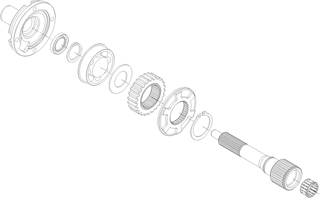Basic Propane Leak Test
The LP Propane system is very important for appliance operation of your RV. It has the potential to be explosive and deadly. Never smoke or have any ignition sources present when filling or servicing a LP System. The propane system must be inspected regularly to avoid unsafe and dangerous conditions. Liquid Propane is very safe and convenient if all safety precautions are followed. Propane has a very small window of opportunity for ignition or explosion. A precise mixture of 2.15% to 9.6% LP gas mixed with air is required for ignition. A 25 to 1 air fuel mixture is required for proper ignition. Any less, or any more LP fuel mixture than that, it will not ignite, so it is considered a very stable fuel. Propane is 1.5 times heavier than air so it always settles at low points. This is why a properly installed RV LP Leak Detector is located at floor level.
Any rotten egg smell is an indication of an LP leak. This rotten egg odor is caused by a chemical called Ethyl Mercaptan, that is mixed in the LP gas at a rate of 1 Lb. Per 10,000 gallons of LP. The initial Rotten egg smell is noticed at 1/5th the LP element level of flammability.
A propane leak test can be performed in a few minutes, by a certified LP technician. Basic leak test can be performed by you. If you have a fifth wheel or travel trailer equipped with a Automatic Change Over Regulator, a simple test can be performed. Turn the main LP Gas Valve to the on position and listen for the initial PSST sound. After a second or two, the sound of flowing LP should stop. Next step is to notice the green band in the clear regulator cap. Now turn the main LP gas valve off at the LP tank for 3 to 4 minutes. Watch the green band in the clear regulator window, and it should stay green. If it turns red, (low gas indicator), this indicates a possible leak. A inline tank level pressure gauge can be used for most every other application. These gauges have a pointer needle that can be watched after performing the steps above. If the pointer drops, a leak is present.
Most leaks are at the LP Regulator, or fittings. Pinpoint location of an LP leak can be found by turning on the LP gas and using a spray bottle filled with a LP Leak Solution, or MR Bubbles soap solution. A electronic LP Leak Detector is inexpensive and can be used to locate LP leaks. Simply spray all the fittings,regulator, hoses, and LP joints at all the LP Appliances with the leak or soap solution, or slowly pass over with the electronic leak detector. Any presence of bubbles or a beep indicate an LP leak. Turn off the LP valve and inspect the leaking fitting for cracks. If the fitting appears satisfactory, simply tighten the fitting. Turn on the LP gas valve and repeat the steps posted above.
It is very important to remember that any LP leak is dangerous and is not acceptable. A regulator lock out and pressure drop test should be performed by a Qualified RV Technician to assure proper operation of the LP system.
